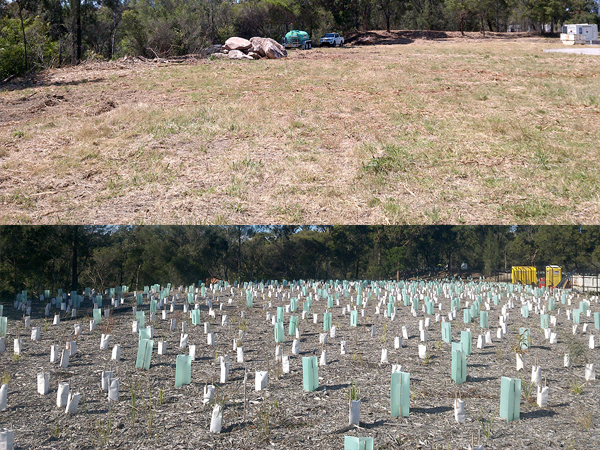From wildland to bushland: A landscape transformed
By Landcare Australia
From an impenetrable forest of weeds containing 22 noxious species to a native bushland with 64,000 native seedlings – the M2 Macquarie Park Motorscapes site has gone through a dramatic transformation.
This major bush regeneration project in Sydney took place over a period of twelve months on a five-hectare site, with the 64,000th seedling planted in June. It was part of Transurban’s roadside regeneration program, an initiative taking a fresh, new approach to how unused land beside Transurban’s roads can be transformed to benefit communities and the surrounding environment.

A before and after of part of the M2 site.
The M2 Macquarie Park Motorscapes project is the second in a series undertaken by Landcare Australia through its partnership with Transurban, following the regeneration of Melbourne’s Power Street Loop.
The Sydney site sits between the Hills M2 Motorway and Lane Cove National Park, with Shrimptons and Industrial Creeks at either end, draining into the Lane Cove River.
Initial vegetation surveys found 170 flora species on the site or in adjoining areas, of which 22 were noxious weeds and seven were Weeds of National Significance, dominating the flora in much of the site. The site also proved a major source of weed infestation for the neighbouring National Park. The riparian zones of both creeks were severely degraded by woody weeds and an understorey of exotic ground covers. Their banks were undercut and badly eroded, and the creeks were carrying gross pollutants and contaminants from upstream of the site.
The task at hand was a mammoth one. Rehabilitation commenced in spring 2016 with weeds controlled and removed using a combination of methods. Workers utilised excavator and positrak mounted forestry mulching heads and manual lopping, with teams of bush regenerators involved in follow-up work, controlling weeds in the understorey.
The riparian and aquatic habitat of Shrimptons Creek and Industrial Creek has been improved by stabilising the creek banks with sandstone revetment to reduce erosion and sediment transport downstream. Installation of gross pollutant traps on each creek put a stop to contaminants being carried downstream to the Lane Cove River.
The facts and figures from the regeneration process are impressive: 10,350 man hours have gone into the transformation; 4,000m3 of topsoil and 2,500m3 of mulch was used on the site; 33,000 tree guards were installed; and 64,000 native tubestock were planted.
A flora and fauna monitoring assessment conducted in June 2017 to compare with the original baseline assessment already shows a significant increase in the ecological value of the site as a direct result of the project works. One example of this can be seen at Industrial Creek where the area has been eradicated of introduced flora species, and a total of 5,000 native tubestock were planted to reinstate the natural ecosystem.
Ongoing, intensive maintenance by a committed bush regeneration team is essential to secure the continued rehabilitation of the site and prevent a reversal of weed dominance. While motorists enjoy the vibrant artwork, Kinetica, that rises out of the site, ongoing work in the background will be undertaken by Landcare Australia to help the native bushland thrive, creating a valuable ecological buffer between the motorway and Lane Cove National Park.



